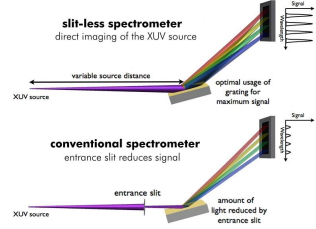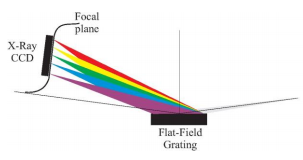Slit-less Technology in Spectrometer
Direct imaging of the source In contrast to conventional devices the innovative XUV / VUV spectrometers by HP do not require a narrow entrance aperture but rather image the harmonic source directly onto the detector. Thus 80% or more of the incoming beam can be used for measurement. This configuration typically collects 15 to 25 times more light than standard versions, resulting in a signal-to-noise figure improved by the same ratio. In some experiments, this improved signal strength is the crucial step for realizing a measurement at all. |  |
Superior signal strength
The amount of light collected by the spectrometer is the key factor influencing its overall sensitivity and ultimately the most important feature required to obtain high
quality data even from weak sources. Conventional spectrometers use an entrance aperture (slit) at a fixed distance from the grating to create a small source which
is then dispersed and imaged onto the detector. In contrast to that the H+P spectrographs can be configured to directly image a radiation source positioned at any
distance from the grating onto the detector. In practice this allows for the collection of 15 to 25 times as much light from point-like radiation sources compared to a
conventional spectrometer with a 100µm entrance slit without degradation in spectral resolution.
Rugged design
The compact design of our XUV and VUV spectrometers makes them inherently insensitive against mechanical and environmental disturbances (vibrations, acoustics,
etc). No moving parts on the outside and closed-loop motors with absolute position monitoring inside the instrument add to the robustness and allow for monitoring of
the grating alignment at all times. The spectrometer can be bolted directly to a vacuum chamber and is capable of carrying its own weight. No table required. The
design also allows mounting in virtually any orientation.
Robust against misalignment
Owing to the rugged design even smaller bumps do not influence the instruments alignment. If the instrument is knocked heavily while the motor control is enabled, the
grating can be repositioned to the saved setting using the grating positioning motors. In addition the concept of a spectrometer without entrance slit also makes the
instrument less sensitive to misalignment. Under typical operating conditions a misalignment of the beam in the dispersion direction on the entrance of the spectrometer
by 500um would lead to a signal reduction by more than 20% in an instrument with entrance slit, while it is less than 10% for our design.
Flat-field imaging technology All our spectrometers are based on high quality aberration-corrected flat-field gratings. In contrast to conventional gratings these focus all wavelengths onto a plane rather than a circle. This allows for positioning the entire detector in the focal plane of the grating for superior spectral resolution. |  |
Take a